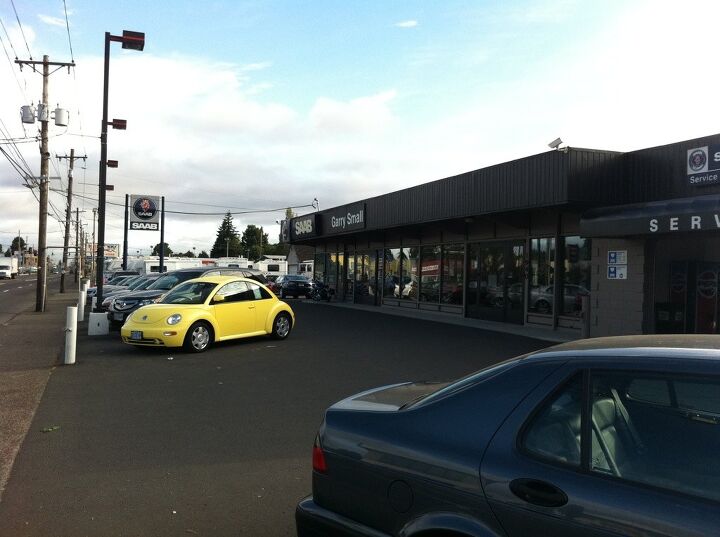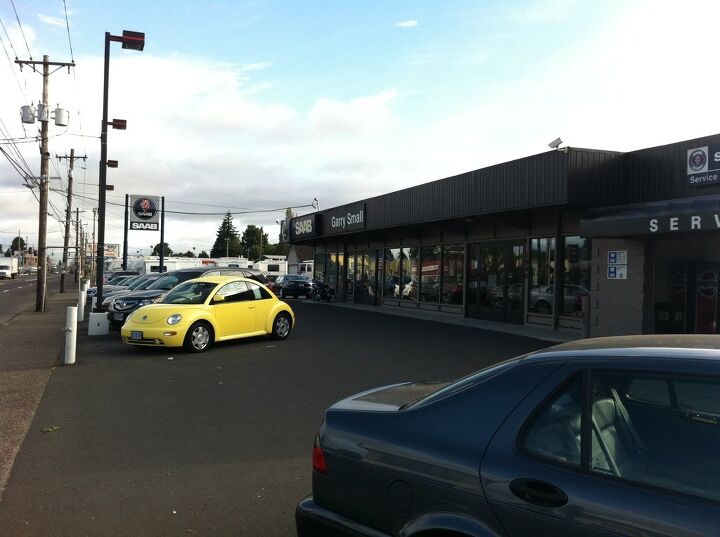This Is What A Year's Supply Of Saabs Looks Like
Portland’s 82nd Avenue is one of those streets that exists in nearly every American city. Unofficially demarcating Portland proper (“the right side of the tracks”) from the extensive working-class suburbs that bleed into Gresham (“the wrong side of the tracks”), “Shady-Second” is home to a vast strip of wall-to-wall buy-here-pay-here lots, used-car hustlers, and small repair shops that line both sides of the road from Sandy Boulevard all the way down to Division. Like every other used-car strip in every other town in America, it’s where folks go when they need a car and don’t have much money to spend. Unlike most other low-cost car Meccas, however, 82nd Avenue is also home to Oregon’s last remaining Saab dealership. And it’s something of a symbol of the hell that Saab dealers are going through right now.
Though I drive past it with some regularity (I live closer to “the tracks” than it’s fashionable to admit), today marked the first time I ever visited Garry Small Saab. Not because I haven’t been intrigued by the struggles of the few remaining Saab dealers, mind you, but because it’s hard to get any blogger out from behind his computer to chase a story. But when Automotive News [sub] quoted Mr Small in a piece today entitled Steady drip of bad news wears on Saab dealers, I knew I had to stop by. Though I’m extremely pessimistic about Saab’s chances of survival, and I’ve been highly critical of Victor Muller’s leadership, I feel nothing but sympathy for the dealers who are left to carry on the ground war. Anyone left in the Saab game after two years of a living PR nightmare has my complete sympathy and respect.
It’s certainly not hard to feel for Mr Small’s dilemma. Having bit his tongue around the media (to the best of my knowledge) for the last several years, Mr Small’s quote to AN [sub] betrays no sign of bitterness or anger; the facts simply speak for themselves.
Garry Small, owner of Garry Small Saab in Portland, Ore., has sold 15 new Saabs this year — but none since June. He has 14 in stock at his Saab-exclusive store.
“Sales have been absolutely flat,” he said. “At this rate of sales, we’ve got a two-year supply, you might say.”
Like other Saab dealers, Small has boosted used-car volume and relies more heavily on service operations.
“There’s no problem with parts and service,” he said. “That’s what’s keeping the doors open.”
By the beginning of June of this year, AN [sub] calculated Saab’s average inventory at a 248 days (prompting us to wonder why Saab was so concerned about restarting production). Based on his current selling rate, however, that number appears to have nearly tripled for Mr Small, whose 14 in-stock new Saabs account for something like a 700-day supply. Small doesn’t appear to be angry or bitter about the experience: after all, he hasn’t had problems with service the way some other Saab dealers have, with one telling AN [sub] that he had to wait 187 days for a 9-7x replacement hood. And because Portland is the kind of city that bought quite a few Saabs before “the troubles” (but wasn’t far enough in love with the brand to inspire hordes of specialty shops ala Volvo, Mercedes and Subaru), there’s plenty of service business to keep things afloat. But when 14 cars makes up a two-year supply, that service business just won’t last forever.
When I showed up at Small Saab this morning, finding it nestled between a buy-here-pay-here lot featuring English and Spanish signage and a used RV business, I didn’t see 14 new Saabs. In fact my first impression was of the used cars out front, which included a few 9-3s, a 9-5 and a 9-7x, as well as a New Beetle, Acura RDX and other entry-premium used vehicles. But on the North side of the building, lined up in a row, were six brand-new Saabs, mostly 9-5s, waiting for buyers. Evidently Mr Small wants to keep his visible stock to a roughly one-year supply. Opposite the new Saabs, though, was a seemingly endless row of 9-3s of every variety, reflecting the morning sun. With several hundred-thousand dollars of used Saab stock on hand, I was suddenly very curious about the level of demand for the brand’s used models. And though Small mentioned that service was his major earner, the service drop-off point held only a 9-5 wagon and, curiously, a TR6 and MGB (which are apparently part of the dealership’s used-car inventory). If anything can keep a service bay open, it’s a pair of British sportscars… but was that really keeping Oregon’s last Saab dealer above water? [Ed: please note that this is what we in the business call a “rhetorical question”]
Sadly, Mr Small was not in to answer my questions. After handing the friendly desk attendant my card, I was treated to a long, quizzical look. “We’re actually a fairly good-sized blog,” I explain, “and I saw Mr Small quoted in Automotive News… is there any chance I could ask a few questions?” An eyebrow moved, barely perceptibly. “Oh I know who you are,” I was told. “We’ve read TTAC. Unfortunately, Mr Small won’t be in until tomorrow.”
I left a card, and encouraged my somewhat stand-offish liason to pass it along to Mr Small, explaining that I sympathized with his plight and simply wanted to give him a chance to tell the world the truth about what it’s been like to be a Saab dealer over the last several years. As I drove away, I knew there was a good chance he wouldn’t call back. After all, if you’ve hung onto a Saab franchise for this long, why give up now?
The answer to that question, it seems, can be found in Sweden. Last week, we heard one of Sweden’s largest Saab dealers lambast the company, telling the press
For me, it is important to be proud of the brands that we have in our halls. Saab does not deliver cars they promised, they do not pay wages to their employees, nor debts to their suppliers while the owners pick out big money. It does not feel right for a [my] car dealers.
And now SvD.se reports that another major Swedish dealer has removed the Saabs from his ten showrooms, explaining
We have taken a time out and removed the show cars. It is sad, but there is no reason to work with selling cars that no one knows if or when they can be delivered
And it’s not just Sweden anymore: the AN [sub] story that quoted Small noted that eight of Saab’s 204 US dealers have closed their new car franchises, and quotes another dealer as saying he wishes he could drop out of the Saab game:
“I’d like to sell my Saab franchise, but it has almost no value right now,” said the dealer, who asked not to be identified. “To go from a top 10 dealer to crickets in the showroom — it’s a sign.”
Finally, the alternative to switching to used cars or trying to pick up a new franchise is also clear: the Albany Times-Union reports that
Fred Carl’s New Salem Garage Inc. has filed for Chapter 7 liquidation in Albany bankruptcy court, listing $1.63 million in liabilities and $254,000 in assets.
The Colonie Saab dealership closed Aug. 12 after more than a half-century in business… The decline in sales is reflected in New Salem Garage’s own financial performance. Its sales fell from $6.2 million in 2009 to $2.7 million last year and just $1 million through early August of this year.
With debt collectors closing in on Saab and freezing at least one of its accounts, workers complaining that they’ve received no guarantee that their next paycheck will arrive on time, and dealers dropping like flies, there’s nothing to gloat about here. The long, messy, highly public collapse of Saab is nothing short of a tragedy. But for precisely this reason it can’t be ignored or whitewashed. Anyone interested in the car business needs to look closely at Saab’s example as a warning sign that this business is merciless, and no place for unfounded optimism. And I really do hope Mr Small decides to give me a call and share his perspective… after all, there’s no better way to learn from history than to hear from the guys manning the front lines.
More by Edward Niedermeyer
Latest Car Reviews
Read moreLatest Product Reviews
Read moreRecent Comments
- Steve Biro I don’t bother with dedicated summer or winter tires. I have no place to store them. But the newest all-weather tires (with the three-peak mountain symbol) are remarkably good year-round. The best of them offer 90 percent of the performance of winter tires and still fall mid-pack among summer ultra-high performance tires. That’s more than enough for my location in New Jersey.
- Carfan94 Never, it doesn’t get cold eneough here in TN, to switch to winter tires. But it gets cold enough that running Summer tires year round is impractical. I’m happy with my All seasons
- Analoggrotto Anyone who has spent more than 15 minutes around a mustang owner would know this will be in insta-hit.
- Akear If this is true then they won't go out of business. Good for them!
- FreedMike Interesting time capsule.










































Comments
Join the conversation
Why don't the dealers cut the prices on their stock. The cars are not getting anymore valuable sitting there.
In Queens NYC there is a Saab franchise part a of Cadillac, GMC and Chevy dealer. It became common post 90 GM sale to add the brand. They used to carry Pontiac/Olds as well. I see Saab's on sale starting mid-20's for a 9-3 which is a good deal compared to a Subaru, Kia etc. In the recent Consumer Reports auto issue they rate the newest 9-3 below-par basically since it's competitors have vastly improved their products. They used to rank them better than average. This could be another reason why people are shying away from them.